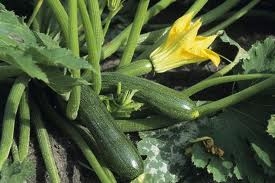
At my house, zucchini appears on the table steamed, shredded, roasted, grilled, dressed and plain. When I have an abundance of zucchini, it finds its way into soups, vegetable loaves, frittatas, quiches and ratatouille, the Provençal summer vegetable stew.
Grated zucchini is a great addition to sweet and savory breads, adding moisture and reducing the need for fats or oils. In a chocolate cake, zucchini is undetectable to all but the most discerning child. And zucchini is easy to grow.
Most zucchini grows on non-vining bushes. The variety known as zucchino rampicante or ‘Tromboncino’ can travel quite a distance around the garden. It is warm enough now to plant zucchini from seed. Plant again halfway through the summer and replace tired plants.
Zucchini is a heavy feeder, so provide generous helpings of compost and a rich mix of nutrients. Like most squash, it also needs consistent and ample moisture to yield well.
Zucchini plants have both male and female flowers. Female flowers appear first on heirloom varieties and second on hybrids. Male squash flowers do not produce fruit but have long, slender stems and a center of golden pollen. Female blossoms are large and squatty, with a tiny squash embryo at the base.
For squash to develop, pollen from the male must be transferred to the female. If you have ever noticed tiny squash that did not develop and then fell off, those were female blossoms that were not successfully pollinated.
Gardeners sometimes wonder why they see many flowers on their squash plants but no squash. That could be because both male and female flowers are not yet present. If you do have flowers of both sexes and still no squash, you may have a pollination problem.
If pollinators are scarce in your garden, take matters into your own hands. Find a small paint brush. Locate one of the smaller male flowers on a slender stem, collect the yellow pollen on your clean paint brush, and dust it into the squattier female blossom. Baby zucchini should follow in due time.
In many parts of the world, zucchini flowers are considered as delicious and useful as the squash. Zucchino da fiore is a variety favored in Italy for the abundant blossoms the plants produce, but any squash blossom, male or female, is edible. Pick blossoms early in the morning and transport them carefully to the kitchen. Stuff with mozzarella, dip in flour or batter, and fry.
At the store or farmers’ market, look for perky blossoms with no sign of wilting. Handle carefully and use within a day or two. Blossoms are fragile and do not hold up long. Best to pick them in your own garden the morning you are going to use them.
By picking and cooking some of the blossoms, you slow the avalanche of zucchini that a good growing season can bring. For a variety of squash-blossom recipes, check out http://www.bonappetit.com/ideas/zucchini-blossom-recipes/search.
It can be hard to decide which zucchini to grow as there are many good choices. ‘Tromboncino’ (shaped like a trombone) is a long, curving, light green to tan zucchini that can reach three feet in length yet still stay tender and creamy. ‘Ronde de Nice’ is a round zucchini, light green or celadon grey. Picked when only two to four inches across, it is great for stuffing or individual servings.
Consider a traditional dark-green zucchini, such as ‘Raven’ or the striped ‘Romanesco’ or ‘Safari.’ Tender-skinned pale varieties include ‘Clarimore,’ ideal for grilling or steaming. Shred and freeze extra zucchini in plastic bags to pull out for fritters, cakes, soups and breads later.
Workshop: Napa County Master Gardeners will lead a workshop on “Succulents in Your Garden” on Saturday, June 15, from 9:30 a.m. to 11:30 a.m. at Napa Valley College’s Upper Valley Campus, 1088 College Avenue, St. Helena. Learn what succulents will grow best in our climate and how to utilize them in your garden design. Learn how to care for them and keep them looking good and free from pests and diseases.
Online registration (credit card only)
Mail in registration (cash or check only)
Master Gardeners are volunteers who help the University of California reach the gardening public with home gardening information. Napa County Master Gardeners (http://ucanr.org/ucmgnapa) are available to answer gardening questions in person or by phone, Monday, Wednesday and Friday, 9 a.m. to Noon, at the U. C. Cooperative Extension office, 1710 Soscol Avenue, Suite 4, Napa, 707-253-4143, or from outside City of Napa toll-free at 877-279-3065. Or e-mail your garden questions by following the guidelines on our web site. Click on Napa, then on Have Garden Questions?